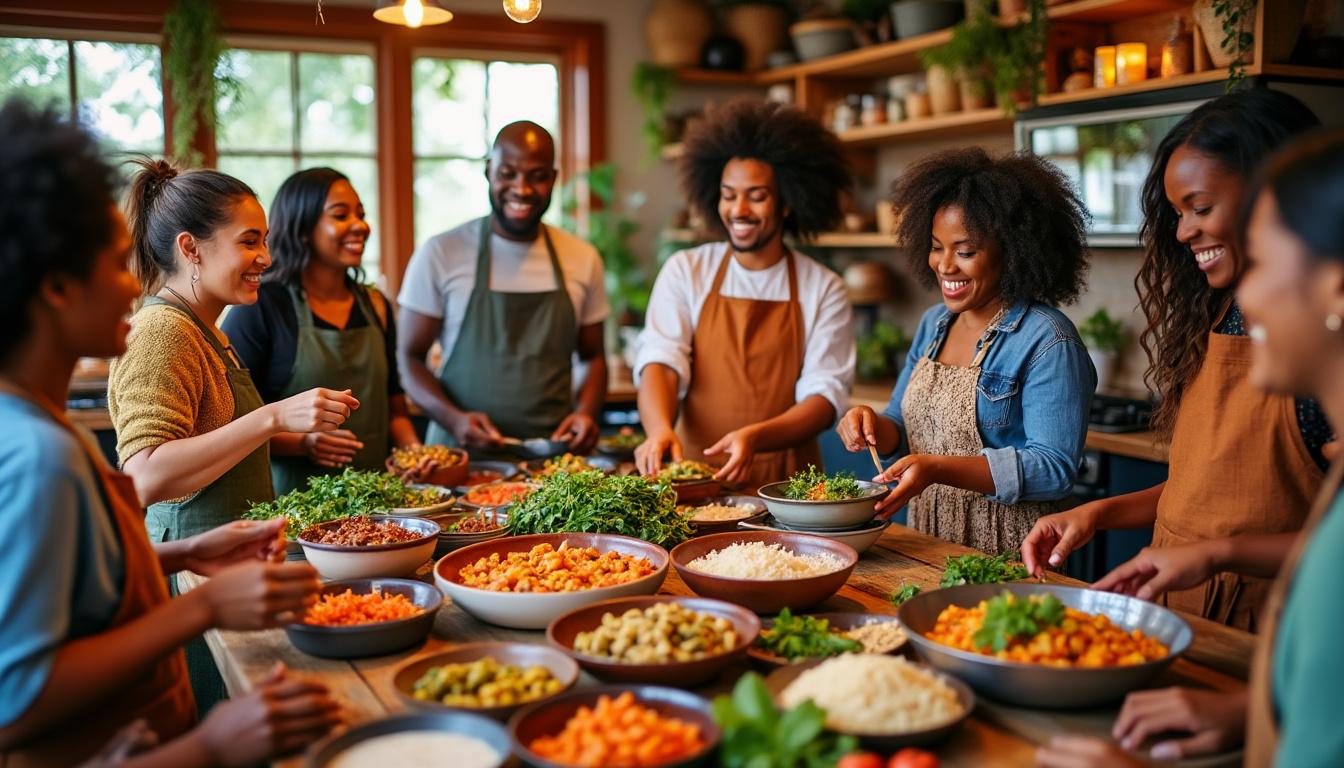Culinary Delights unite communities through shared recipes and cultural exchange—explore how Culinary Delights create moments of connection, from the Global Table to home kitchens.
Short, evocative stories and practical tips reveal how food becomes a language of empathy. This piece maps examples, techniques and local initiatives that turn ingredients into dialogue.
Culinary Delights and the Global Table: How Shared Meals Create Unity
Across neighborhoods and nations, Culinary Delights act as a bridge: an invitation to taste history and swap perspectives. The idea of a Global Table reframes recipes as portable stories that travel with migrants, travelers, and chefs.
A fictional initiative, Crossroads Kitchen, serves as the thread connecting each vignette below, showing how a single community space can host workshops, swaps and tasting nights that become traditions.
Crossroads Kitchen: A Model For Tasting Together
Crossroads Kitchen programs focus on practical exchange: shared pantry pantry swaps, translation of family recipes and community dinners. These events prioritize accessibility and mutual respect.
- Monthly “The Shared Dish” nights where families bring one recipe and one story.
- Workshops titled Hearts & Recipes that pair elders with youth to preserve oral culinary memory.
- Pop-up Flavor Bridges dinners highlighting fusion techniques and local produce.
These activities turn strangers into neighbors through tangible, tactile experiences of taste. The Crossroads Kitchen model proves that Culinary Delights can be intentionally designed to foster belonging.
Hearts & Recipes: Stories That Shape Gathered Flavors
Family recipes are portable time capsules; every spoonful conveys place, migration and resilience. Events that emphasize Hearts & Recipes give voice to personal histories while teaching new techniques.
A case study from Crossroads Kitchen demonstrates how one recipe swap morphed into a neighborhood herb garden project that supplied weekly dinner tables.
Community Practices That Amplify Cultural Exchange
Small, repeatable practices create cultural literacy around food. Below are approaches used by community kitchens and cultural festivals:
- Seed-to-table classes that combine gardening and cooking—connecting soil stories to recipes.
- Recipe translation sessions pairing culinary terms with cultural notes to deepen understanding.
- Shared tasting menus labeled by origin story rather than country, fostering curiosity.
Those practices show how Culinary Delights can evolve into collective knowledge and civic pride.
| Program | Example Activity | Impact |
|---|---|---|
| The Shared Dish | Weekly community potluck featuring a rotating theme | Boosts social bonds; preserves immigrant recipes |
| Unity Spoon | Intergenerational spoon-cooking workshops | Protects culinary memory; teaches technique |
| Cultural Bites | Short, focused tastings coupled with micro-lectures | Introduces new flavors with context |
| Worldly Plates | Pop-up dinners with guest cooks from the neighborhood | Promotes small-business visibility and cross-cultural sales |
Cultural Bites and Flavor Bridges: Practical Recipes for Unity
Practical steps turn intention into repeatable outcomes. From sourcing ingredients locally to pairing recipes with stories, a planner can scale Culinary Delights into lasting programs.
Crossroads Kitchen expanded by collaborating with local gardens and youth programs, converting tasting nights into ongoing educational series.
Actions You Can Adopt Tomorrow
Concrete actions help kitchens, community centers and schools bring people together through food:
- Create a rotating Global Table calendar with themes and guest storytellers.
- Start a neighborhood herb bed tied to recipe workshops—see guidance for indoor and outdoor gardens: Indoor edible plant garden and Outdoor space garden tips.
- Engage children with seed-to-plate programs: Children gardening passion and Children garden passions provide activity ideas.
- Offer guide materials for cooks launching community plots: Tips for launching your own garden.
- Pair cooking swaps with local garden shows or events like Hilliard home garden show to attract broader audiences.
These steps enable small teams to transform Culinary Delights into reproducible rituals that expand participation and deepen cultural empathy.
Scaling Impact: From The Shared Dish To Citywide Programs
Scaling requires partnerships—restaurants, schools, and garden groups can amplify reach. Linking a cooking program to local gardening resources creates a pipeline of ingredients and learning.
- Partner with local media and guides to advertise events and educational resources: Trading cooking garden guide.
- Convert pop-ups into week-long residencies that spotlight culinary newcomers.
- Document stories and recipes for a community archive, fostering long-term preservation.
When networks align, Culinary Delights become an engine for economic opportunity and cultural exchange.
Practical Cookbook Starter List
- Simple, replicable recipes that use seasonal produce and require standard tools.
- Short cultural notes accompanying each recipe, explaining origin and family variations.
- Guides for sourcing or growing key ingredients locally; check community resources: Gardening passion enrich lives and Home garden viewer inquiries.
These practical elements help new programs avoid common pitfalls and sustain momentum through community ownership.
Questions And Answers
How can a neighborhood start a meaningful tasting event with limited budget?
Begin with modest invitations to neighbors, a single shared dish per family and a storytelling prompt. Use donated or home-grown produce and partner with local garden initiatives to reduce costs. This approach makes Culinary Delights accessible and scalable.
What roles do gardens play in cultural exchange programming?
Gardens supply fresh ingredients and hands-on learning; they also anchor recipes to place and season. Programs that combine gardening and cooking—seed-to-spoon models—strengthen community ties and preserve culinary heritage.
How can organizers ensure cultural respect when presenting others’ recipes?
Invite recipe-owners to share and contextualize their dishes, credit sources clearly, and prioritize consent for public sharing. Framing events around storytelling and reciprocity transforms Culinary Delights into respectful cultural exchange.
Are there quick digital tools to document shared recipes and stories?
Simple platforms like community blogs, social embeds and shared photo albums work well. Documenting via short videos, audio clips and annotated recipes ensures memory preservation and wider access.
What is the first measure of success for a community food exchange?
Participation and repeated attendance are key early indicators. When neighbors return and bring new dishes or stories, the initiative has shifted from a one-off event to an ongoing cultural practice—true evidence that Culinary Delights are building local belonging.

